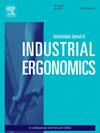How does augmented reality head-mounted display impact the ability to detect safety hazards while performing piping assembly?
IF 3
2区 工程技术
Q2 ENGINEERING, INDUSTRIAL
International Journal of Industrial Ergonomics
Pub Date : 2025-05-01
DOI:10.1016/j.ergon.2025.103751
引用次数: 0
Abstract
Augmented Reality (AR) Head Mounted Displays Devices (HMDDs) have the potential to revolutionize information delivery during the construction phase. However, concerns remain about whether AR HMDDs impact workers' ability to detect changes in their surroundings, which could pose safety risks. In this controlled experiment, one hundred industry craft workers participated in an assembly task on a full-scale Mechanical, Electrical, and Plumbing (MEP) model using three information formats: traditional isometric paper drawings and two AR models at levels of detail (LOD) 300 and 400 that vary based on the density of information provided. A safety hazard scenario was introduced, and the response time to detect the change was recorded. Findings revealed a significant difference in response times, with non-AR HMDD users detecting changes more quickly than AR HMDD users. Further investigation examined the correlation between workers' age, spatial cognition, and response time to detect changes. This study is one of the first in the construction domain to introduce hazards (referred to as change) and examine AR HMDDs’ impact on individuals' ability to detect them.
增强现实头戴式显示器在执行管道装配时如何影响检测安全隐患的能力?
增强现实(AR)头戴式显示设备(HMDDs)有可能在构建阶段彻底改变信息传递。然而,人们仍然担心AR HMDDs是否会影响工人检测周围环境变化的能力,这可能会带来安全风险。在这个对照实验中,100名工业工艺工人参与了一个全尺寸机械、电气和管道(MEP)模型的装配任务,该模型使用三种信息格式:传统的等距纸图和两个AR模型,其细节水平(LOD)为300和400,根据所提供的信息密度而变化。引入了一个安全隐患场景,并记录了检测变化的响应时间。研究结果显示,在反应时间上存在显著差异,非AR型HMDD用户比AR型HMDD用户更快地检测到变化。进一步的研究考察了工人的年龄、空间认知和反应时间之间的相关性,以检测变化。这项研究是建筑领域首次引入危害(称为变化)并检查AR HMDDs对个体检测它们的能力的影响。
本文章由计算机程序翻译,如有差异,请以英文原文为准。
求助全文
约1分钟内获得全文
求助全文
来源期刊
CiteScore
6.40
自引率
12.90%
发文量
110
审稿时长
56 days
期刊介绍:
The journal publishes original contributions that add to our understanding of the role of humans in today systems and the interactions thereof with various system components. The journal typically covers the following areas: industrial and occupational ergonomics, design of systems, tools and equipment, human performance measurement and modeling, human productivity, humans in technologically complex systems, and safety. The focus of the articles includes basic theoretical advances, applications, case studies, new methodologies and procedures; and empirical studies.

 求助内容:
求助内容: 应助结果提醒方式:
应助结果提醒方式:


